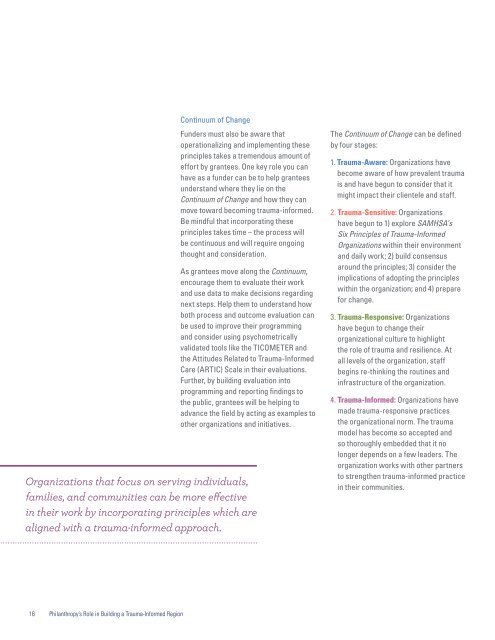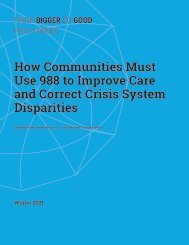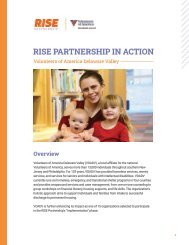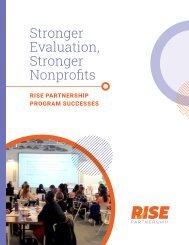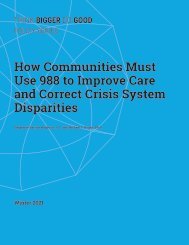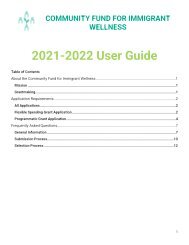Trauma-Informed Philanthropy Vol1
Create successful ePaper yourself
Turn your PDF publications into a flip-book with our unique Google optimized e-Paper software.
Continuum of Change<br />
Funders must also be aware that<br />
operationalizing and implementing these<br />
principles takes a tremendous amount of<br />
effort by grantees. One key role you can<br />
have as a funder can be to help grantees<br />
understand where they lie on the<br />
Continuum of Change and how they can<br />
move toward becoming trauma-informed.<br />
Be mindful that incorporating these<br />
principles takes time – the process will<br />
be continuous and will require ongoing<br />
thought and consideration.<br />
As grantees move along the Continuum,<br />
encourage them to evaluate their work<br />
and use data to make decisions regarding<br />
next steps. Help them to understand how<br />
both process and outcome evaluation can<br />
be used to improve their programming<br />
and consider using psychometrically<br />
validated tools like the TICOMETER and<br />
the Attitudes Related to <strong>Trauma</strong>-<strong>Informed</strong><br />
Care (ARTIC) Scale in their evaluations.<br />
Further, by building evaluation into<br />
programming and reporting findings to<br />
the public, grantees will be helping to<br />
advance the field by acting as examples to<br />
other organizations and initiatives.<br />
Organizations that focus on serving individuals,<br />
families, and communities can be more effective<br />
in their work by incorporating principles which are<br />
aligned with a trauma-informed approach.<br />
The Continuum of Change can be defined<br />
by four stages:<br />
1. <strong>Trauma</strong>-Aware: Organizations have<br />
become aware of how prevalent trauma<br />
is and have begun to consider that it<br />
might impact their clientele and staff.<br />
2. <strong>Trauma</strong>-Sensitive: Organizations<br />
have begun to 1) explore SAMHSA’s<br />
Six Principles of <strong>Trauma</strong>-<strong>Informed</strong><br />
Organizations within their environment<br />
and daily work; 2) build consensus<br />
around the principles; 3) consider the<br />
implications of adopting the principles<br />
within the organization; and 4) prepare<br />
for change.<br />
3. <strong>Trauma</strong>-Responsive: Organizations<br />
have begun to change their<br />
organizational culture to highlight<br />
the role of trauma and resilience. At<br />
all levels of the organization, staff<br />
begins re-thinking the routines and<br />
infrastructure of the organization.<br />
4. <strong>Trauma</strong>-<strong>Informed</strong>: Organizations have<br />
made trauma-responsive practices<br />
the organizational norm. The trauma<br />
model has become so accepted and<br />
so thoroughly embedded that it no<br />
longer depends on a few leaders. The<br />
organization works with other partners<br />
to strengthen trauma-informed practice<br />
in their communities.<br />
16 <strong>Philanthropy</strong>’s Role in Building a <strong>Trauma</strong>-<strong>Informed</strong> Region


